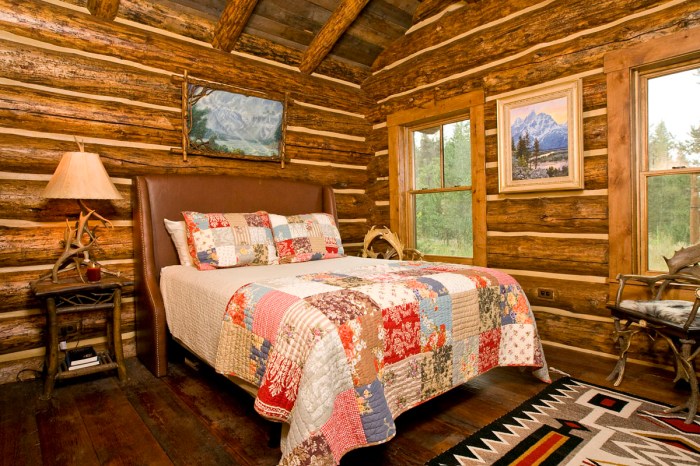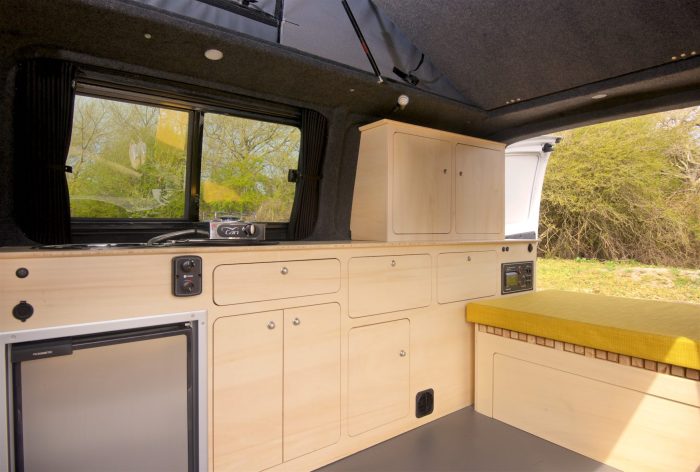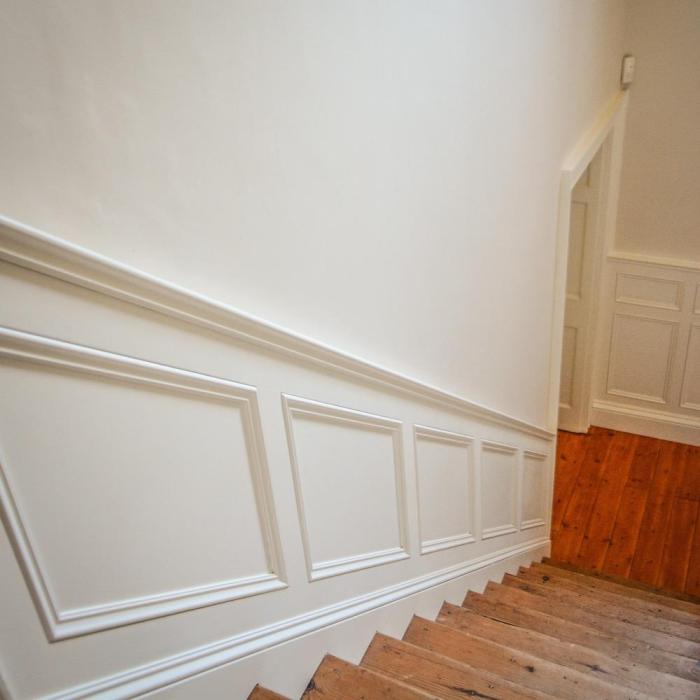Unveiling a world of canopy ideas, this guide is your passport to transforming your outdoor haven into a sanctuary of style and functionality. Dive into a realm of designs, materials, colors, and accessories, empowering you to craft a canopy that perfectly complements your vision.
From ethereal elegance to vibrant boldness, the possibilities are limitless. Canopy ideas await, ready to inspire your next outdoor masterpiece.
Canopy Designs: Canopy Ideas
Canopies are a beautiful and functional addition to any outdoor space. They provide shade from the sun, shelter from the rain, and can even be used to create a cozy outdoor living area. There are many different types of canopy designs available, each with its own unique advantages and disadvantages.
Freestanding Canopies
Freestanding canopies are not attached to any other structure and can be placed anywhere in your yard or garden. They are typically made of a lightweight metal frame and a waterproof fabric canopy. Freestanding canopies are easy to set up and take down, making them a great option for temporary shade.
Pros:
- Easy to set up and take down
- Can be placed anywhere
- Lightweight and portable
Cons:
- Not as stable as other types of canopies
- Can be blown over in strong winds
Attached Canopies
Attached canopies are attached to a permanent structure, such as a house or a deck. They are typically made of a more durable material than freestanding canopies, and they are more resistant to wind and rain.
Pros:
- More durable than freestanding canopies
- More resistant to wind and rain
- Can be customized to match your home’s exterior
Cons:
- More difficult to set up and take down
- Cannot be moved once they are installed
Retractable Canopies
Retractable canopies are a great option for people who want the convenience of a canopy without the hassle of setting it up and taking it down. Retractable canopies are attached to a permanent structure, but they can be retracted when not in use.
This makes them a great option for patios, decks, and other outdoor areas where you want to be able to enjoy the sun and shade.
Pros:
- Convenient and easy to use
- Can be retracted when not in use
- Can be customized to match your home’s exterior
Cons:
- More expensive than other types of canopies
- Can be difficult to install
Canopy Materials
Canopies are a great way to add shade and style to your outdoor space. They come in a variety of materials, each with its own advantages and disadvantages.Here is a look at some of the most popular canopy materials:
Fabric
Fabric canopies are a popular choice because they are relatively inexpensive and easy to install. They are also available in a wide variety of colors and patterns, so you can find one that matches your décor. However, fabric canopies are not as durable as some other materials, and they can fade or tear over time.
Metal
Metal canopies are more durable than fabric canopies, and they can withstand strong winds and rain. They are also fire-resistant, making them a good choice for areas where there is a risk of fire. However, metal canopies can be more expensive than fabric canopies, and they can be difficult to install.
Wood
Wood canopies are a beautiful and natural choice for outdoor spaces. They are durable and can withstand the elements, and they can add a touch of warmth and elegance to your décor. However, wood canopies can be expensive, and they require regular maintenance to keep them looking their best.
Vinyl
Vinyl canopies are a good choice for areas where there is a lot of rain or snow. They are waterproof and can withstand strong winds. However, vinyl canopies can be difficult to clean, and they can fade over time.
Canopy Colors and Patterns
Canopies come in a wide range of colors and patterns, offering endless possibilities to match your personal style and decor. From vibrant hues to subtle neutrals, geometric prints to intricate florals, there’s a canopy to suit every taste.
When choosing colors and patterns, consider the overall aesthetic of your room. Bold colors and eye-catching patterns can create a dramatic focal point, while softer hues and understated designs provide a more calming atmosphere. The size and shape of your canopy also influence the impact of the colors and patterns you choose.
Choosing Colors
- Neutral Colors:White, cream, and beige canopies provide a timeless and versatile backdrop for any decor style. They create a sense of space and tranquility, making them ideal for small rooms or those with limited natural light.
- Vibrant Colors:Blue, green, yellow, and pink canopies add a pop of color and energy to any room. They’re perfect for creating a cheerful and inviting atmosphere, and can be used to complement existing furniture or artwork.
- Dark Colors:Black, navy, and charcoal canopies create a sophisticated and dramatic look. They’re best suited for larger rooms with ample natural light, as they can make smaller spaces feel more cramped.
Choosing Patterns
- Geometric Patterns:Stripes, polka dots, and chevron patterns add a touch of modern flair to any canopy. They’re easy to coordinate with other patterns and textures, and can create a sense of movement and energy.
- Floral Patterns:Delicate florals, lush botanicals, and trailing vines bring a touch of nature indoors. They’re perfect for creating a romantic or bohemian atmosphere, and can be used to add a splash of color or a subtle accent.
- Paisley Patterns:Intricate paisley patterns add a touch of exotic charm to any canopy. They’re often used in traditional or ethnic decor styles, and can create a sense of mystery and intrigue.
Canopy Accessories
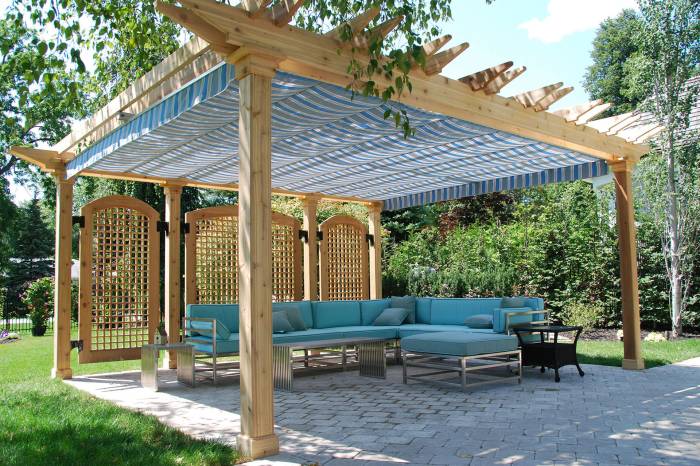
Accessories can enhance canopy functionality, comfort, style, and durability. These include curtains, valances, swags, tiebacks, and finials.
Curtains provide privacy, light control, and insulation. Valances add a decorative touch and conceal the top of the curtains. Swags create a dramatic effect and can be used to frame a window or doorway. Tiebacks hold back curtains when they are not in use.
Finials add a finishing touch to the ends of curtain rods.
Curtains
- Provide privacy, light control, and insulation
- Come in a variety of fabrics, colors, and patterns
- Can be hung from a curtain rod or a track
Valances
- Add a decorative touch and conceal the top of the curtains
- Come in a variety of styles, including flat, gathered, and pleated
- Can be made from the same fabric as the curtains or a contrasting fabric
Swags
- Create a dramatic effect and can be used to frame a window or doorway
- Come in a variety of shapes and sizes
- Can be made from the same fabric as the curtains or a contrasting fabric
Tiebacks
- Hold back curtains when they are not in use
- Come in a variety of styles, including tassels, ropes, and magnets
- Can be made from the same fabric as the curtains or a contrasting fabric
Finials
- Add a finishing touch to the ends of curtain rods
- Come in a variety of styles, including balls, cones, and spheres
- Can be made from a variety of materials, including wood, metal, and plastic
Canopy Installation

Installing a canopy can be a straightforward task if you follow the right steps and take necessary safety precautions. Here’s a step-by-step guide to help you install your canopy successfully.
Step 1: Gather Materials and Tools
Before you begin, gather all the necessary materials and tools, including the canopy, mounting hardware, a drill, a screwdriver, a level, a measuring tape, and safety glasses.
Step 2: Determine the Mounting Location
Choose the desired location for your canopy and ensure it has a sturdy structure to support the weight of the canopy. Mark the mounting points on the ceiling or wall using a pencil or chalk.
Step 3: Install the Mounting Hardware
Use a drill to create pilot holes at the marked mounting points. Insert the mounting hardware, such as screws or bolts, and tighten them securely using a screwdriver.
Step 4: Attach the Canopy
Align the canopy with the mounting hardware and carefully lift it into place. Secure the canopy by tightening the screws or bolts until it is firmly attached.
Step 5: Level the Canopy
Use a level to check if the canopy is level. Adjust the mounting hardware as needed until the canopy is perfectly horizontal.
Safety Precautions
- Always wear safety glasses when using power tools.
- Ensure the mounting surface is strong enough to support the weight of the canopy.
- Use appropriate hardware and tools for the specific type of canopy and mounting surface.
- If you are not confident in your DIY skills, consider hiring a professional installer.
Tips for a Successful Installation, Canopy ideas
- Measure twice, drill once.
- Use a level to ensure the canopy is straight.
- Tighten all screws and bolts securely.
- If you are installing a heavy canopy, consider using additional support, such as a crossbar or support wires.
Canopy Maintenance
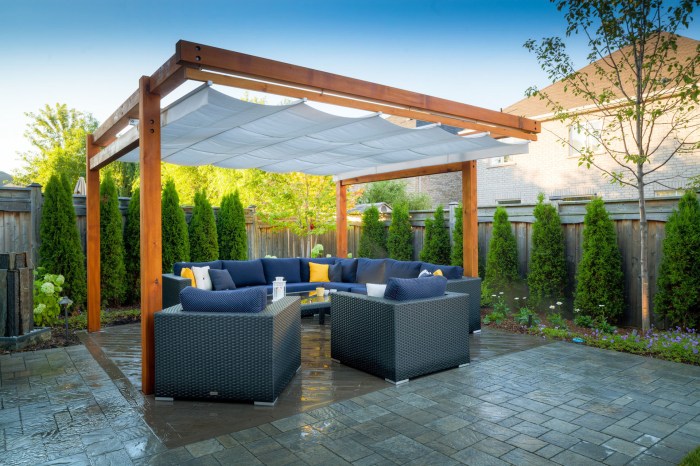
Canopies require regular maintenance to ensure they remain in good condition and provide optimal protection and aesthetics. This includes cleaning, repairing, and storing them properly.
Cleaning
Regular cleaning helps remove dirt, dust, and debris that can accumulate on canopies over time. Use a soft cloth or brush to gently wipe down the canopy surface. For tougher stains, use a mild soap solution and rinse thoroughly with clean water.
Avoid using harsh chemicals or abrasive cleaners, as they can damage the canopy material.
Repairing
If your canopy sustains any tears or damage, it’s important to repair them promptly to prevent further damage and maintain the canopy’s integrity. For small tears, use a canopy repair kit or apply a patch of compatible fabric. For larger tears or damage, consult a professional for proper repair or replacement.
Storing
When not in use, store your canopy in a clean, dry place to protect it from the elements and pests. Fold or roll the canopy loosely to avoid creases or damage. If possible, store the canopy in a breathable bag or container to allow for proper ventilation and prevent mold or mildew growth.
Canopy Applications
Canopies are incredibly versatile structures that offer shade, shelter, and aesthetic appeal in a wide range of settings. From grand outdoor events to cozy backyard retreats, canopies serve diverse purposes, transforming spaces and enhancing experiences.
Outdoor Events
Outdoor events, such as weddings, festivals, and sporting events, often rely on canopies to provide shelter from the sun and rain. They can be customized in size and shape to accommodate different event layouts, creating shaded areas for guests to relax, socialize, or enjoy performances.
Canopy Trends
Canopy design and materials are constantly evolving, influenced by advancements in technology, changing aesthetics, and sustainability concerns. These trends impact the visual appeal, durability, and functionality of canopies.
One notable trend is the increasing use of eco-friendly materials. Canopies made from recycled fabrics, bamboo, and other sustainable materials are gaining popularity as consumers become more environmentally conscious.
Materials
- Recycled Fabrics:Canopies made from recycled polyester, nylon, and other fabrics offer durability and sustainability.
- Bamboo:Bamboo canopies are eco-friendly, UV-resistant, and provide a natural aesthetic.
- Tensile Membranes:Tensile membranes made from materials like PTFE and ETFE are lightweight, durable, and allow for innovative architectural designs.
Design
- Organic Shapes:Canopies with organic shapes, such as curves and arches, create a visually appealing and inviting space.
- Retractable Canopies:Retractable canopies offer flexibility and convenience, allowing users to adjust the coverage area as needed.
- Multi-Layered Canopies:Multi-layered canopies provide increased protection from the elements and create a unique aesthetic.
Functionality
- Integrated Lighting:Canopies with integrated lighting enhance visibility and create a welcoming atmosphere.
- Acoustic Properties:Canopies with sound-absorbing materials reduce noise levels and improve acoustics.
- Smart Technology:Canopies equipped with sensors and automation systems offer remote control and optimization of shade and protection.
Canopy Design Table
To help you visualize the different canopy options available, we’ve created a table that includes the canopy type, material, color/pattern, and accessories.
This table will give you a better understanding of the various canopy designs and help you make an informed decision about which one is right for your needs.
Canopy Design Table
| Canopy Type | Material | Color/Pattern | Accessories |
|---|---|---|---|
| Freestanding Canopy | Aluminum | White | Curtains, sidewalls, lighting |
| Attached Canopy | Vinyl | Beige | Gutters, downspouts |
| Retractable Canopy | Fabric | Blue and white stripes | Remote control, wind sensor |
| Commercial Canopy | Metal | Green | Branding, signage |
Canopy Installation Guide
Installing a canopy is a simple process that can be completed in a few hours. By following these step-by-step instructions, you can ensure that your canopy is installed correctly and safely.Before you begin, gather all of the necessary materials. You will need:
- A canopy
- A frame
- Screws
- A drill
- A level
- A tape measure
Step-by-Step Canopy Installation
- Assemble the frame. Most canopies come with a pre-assembled frame, but if yours does not, you will need to assemble it according to the manufacturer’s instructions.
- Attach the canopy to the frame. Once the frame is assembled, you can attach the canopy by stretching it over the frame and securing it with screws.
- Level the canopy. Once the canopy is attached to the frame, you need to level it. To do this, use a level to check the canopy from all sides. If the canopy is not level, adjust the screws until it is.
- Secure the canopy. Once the canopy is level, you need to secure it. To do this, drill screws through the frame and into the ground. Make sure the screws are long enough to hold the canopy securely in place.
- Enjoy your canopy! Once the canopy is installed, you can enjoy it for years to come. Canopies provide shade from the sun, rain, and wind, and they can also be used to create a private space in your yard.
Canopy Maintenance Checklist
Maintaining canopies is crucial to ensure their longevity, functionality, and aesthetic appeal. Regular inspections and maintenance tasks are essential to keep canopies in top condition.
Regular Maintenance Tasks
- Inspect the canopy regularly for any signs of wear, tear, or damage, such as rips, tears, or broken seams.
- Clean the canopy regularly to remove dirt, debris, and bird droppings. Use a mild soap solution and a soft brush or sponge. Avoid using harsh chemicals or abrasive cleaners, as they can damage the fabric.
- Check the canopy frame for any signs of rust or corrosion. Clean the frame with a damp cloth and apply a rust-resistant coating if necessary.
- Lubricate all moving parts of the canopy, such as pulleys, hinges, and wheels. This will help to ensure smooth operation and prevent wear and tear.
- Store the canopy properly when not in use. Fold or roll the canopy and store it in a dry, well-ventilated area.
Troubleshooting Common Canopy Issues
- If the canopy is sagging or drooping, it may be due to loose or damaged seams. Inspect the seams and repair any damage as necessary.
- If the canopy is leaking, it may be due to a hole or tear in the fabric. Repair the hole or tear using a waterproof sealant or patch.
- If the canopy is difficult to open or close, it may be due to a lack of lubrication. Lubricate all moving parts of the canopy.
- If the canopy is making a noise, it may be due to a loose or damaged part. Inspect the canopy and repair any damage as necessary.
Outcome Summary
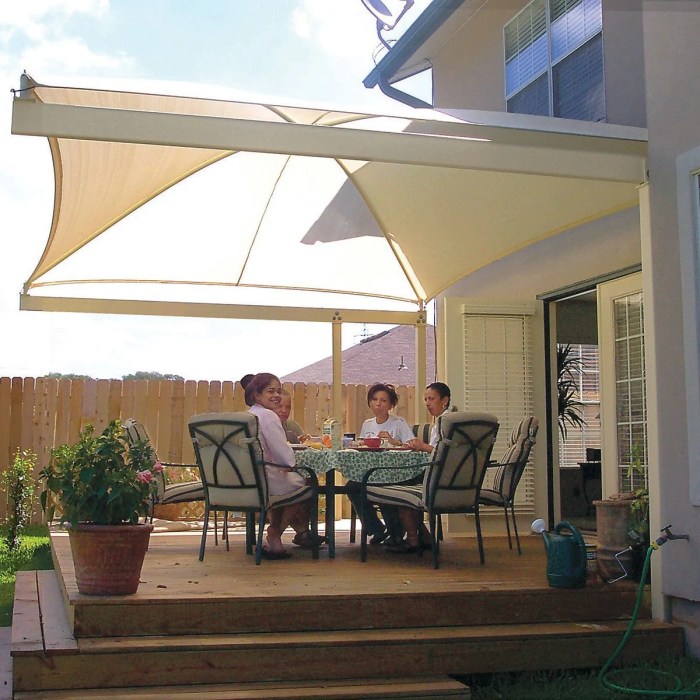
As you embark on your canopy journey, remember that creativity knows no bounds. Embrace the ideas presented here, experiment with different combinations, and let your imagination soar. Your canopy will not only provide shade and shelter but also become a statement piece that reflects your unique style and enhances the beauty of your outdoor space.
FAQ Insights
What are the different types of canopy designs available?
Canopy designs range from classic to contemporary, including dome, pyramid, square, and rectangular shapes, each offering unique aesthetic and functional advantages.
How do I choose the right canopy material?
Consider factors such as durability, weather resistance, UV protection, and aesthetics when selecting canopy materials. Options include canvas, polyester, nylon, and vinyl.
What colors and patterns are trending for canopies?
Neutral hues like beige and gray remain popular, while bolder colors like navy and emerald green are gaining traction. Geometric and floral patterns add a touch of personality.
